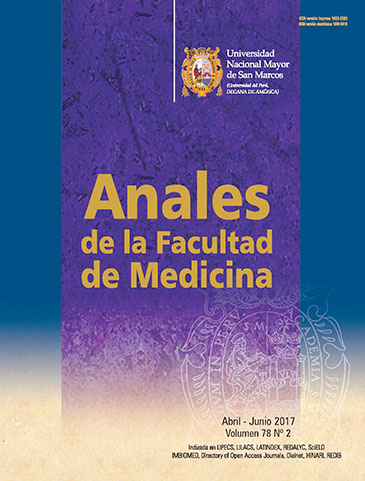Obesity and dyslipoproteinemia
DOI:
https://doi.org/10.15381/anales.v78i2.13217Keywords:
Obesity, Dyslipoproteinemia, Insulin Resistance.Abstract
The definition, main general causes, quantification and body distribution of obesity are described. A general review of the different blood lipoprotein fractions as well as the procedure for the diagnosis of dyslipoproteinemia is done. Dyslipoproteinemia of obesity is a secondary form of insulin resistance as a result of lowering of lipoprotein lipase activity resulting in increase of triglycerides, decrease of HDL cholesterol, and establishment of the metabolic syndrome. Its pathophysiology and the development of obesity related morbidities are described. Dyslipoproteinemia of obesity is present in both the basal and postprandial status. An attempt is made to estimate the prevalence of dyslipoproteinemia. Treatment is outlined and includes change in lifestyle regarding diet and physical activity, pharmacotherapy, and bariatric surgery, as well as the hypolipidemic treatment.Downloads
Published
2017-07-17
Issue
Section
Simposio
License
Copyright (c) 2017 Fausto Garmendia Lorena

This work is licensed under a Creative Commons Attribution-NonCommercial-ShareAlike 4.0 International License.
Those authors who have publications with this magazine accept the following terms:
- Authors will retain their copyrights and guarantee the journal the right of first publication of their work, which will be simultaneously subject to Creative Commons Attribution License that allows third parties to share the work as long as its author and its first publication this magazine are indicated.
- Authors may adopt other non-exclusive licensing agreements for the distribution of the version of the published work (eg, deposit it in an institutional electronic file or publish it in a monographic volume) provided that the initial publication in this magazine is indicated.
- Authors are allowed and recommended to disseminate their work over the Internet (eg: in institutional telematic archives or on their website) before and during the submission process, which It can produce interesting exchanges and increase quotes from the published work. (See El efecto del acceso abierto ).
How to Cite
1.
Garmendia Lorena F. Obesity and dyslipoproteinemia. An Fac med [Internet]. 2017 Jul. 17 [cited 2024 Jul. 17];78(2):196-201. Available from: https://revistasinvestigacion.unmsm.edu.pe/index.php/anales/article/view/13217















